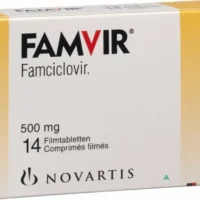Description
Normomed (Inosin Pranobex) Tablets 500 mg. №50
Ingredients
- Each tablet contains 500 mg of inosin pranobex.
Dosage
- The recommended dosage is as directed by a healthcare professional.
Indications
- Normomed tablets are indicated for the treatment of viral infections.
Contraindications
- Do not use Normomed tablets if allergic to any of the ingredients.
Directions
- Swallow the tablets whole with water, with or without food.
Scientific Evidence
Research studies have shown that inosin pranobex, the active ingredient in Normomed tablets, exhibits antiviral properties by enhancing the immune response against viral infections. It has been found to reduce the severity and duration of symptoms in various viral illnesses.
Additional Information
- Normomed tablets have been well-tolerated in clinical trials, with minimal side effects reported. It is important to follow the prescribed dosage and consult a healthcare provider before use, especially in patients with underlying medical conditions or those taking other medications.
- Furthermore, comparative studies have demonstrated the effectiveness of inosin pranobex in managing viral infections compared to traditional antiviral medications. Its unique mechanism of action makes it a promising option for the treatment of viral illnesses.




